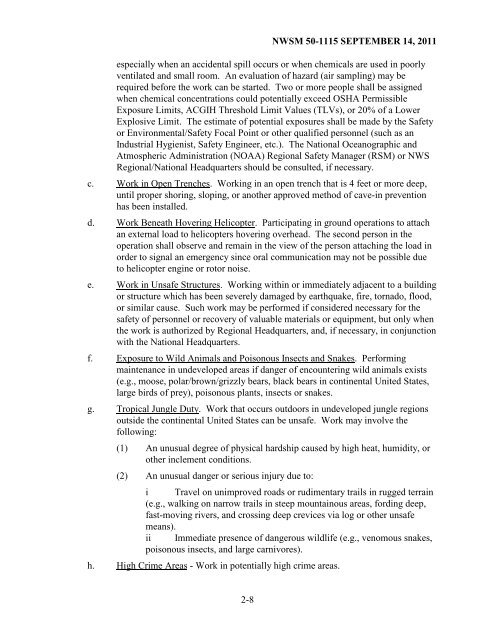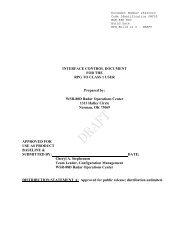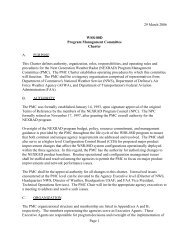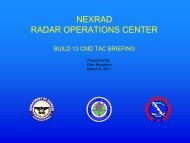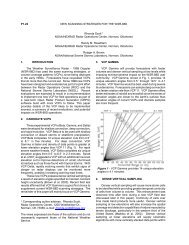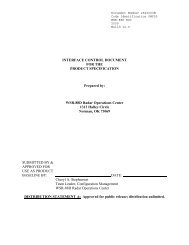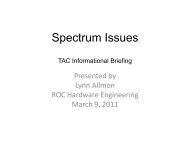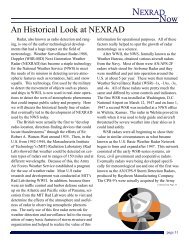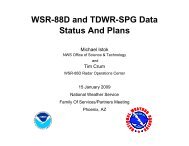- Page 1: Department of Commerce · National
- Page 4 and 5: NWSM 50-1115 SEPTEMBER 14, 2011Syno
- Page 6 and 7: NWSM 50-1115 SEPTEMBER 14, 2011This
- Page 8 and 9: NWSM 50-1115 SEPTEMBER 14, 2011Requ
- Page 10 and 11: NWSM 50-1115 SEPTEMBER 14, 20111 FA
- Page 12 and 13: NWSM 50-1115 SEPTEMBER 14, 2011cons
- Page 14 and 15: NOTE:NWSM 50-1115 SEPTEMBER 14, 201
- Page 16 and 17: 1.3.4 Falling Object ProtectionNWSM
- Page 18 and 19: NOTE:NWSM 50-1115 SEPTEMBER 14, 201
- Page 20 and 21: NWSM 50-1115 SEPTEMBER 14, 20111.6
- Page 22 and 23: ATTACHMENT APre-Use Inspection Guid
- Page 24 and 25: LanyardsInspection ChecklistNWSM 50
- Page 26 and 27: NWSM 50-1115 SEPTEMBER 14, 2011ATTA
- Page 28 and 29: ATTACHMENT CStructure Climbing/Desc
- Page 30 and 31: PROCEDURE 2 - Working AloneNWSM 50-
- Page 32 and 33: Working Alone ChecklistNWSM 50-1115
- Page 34 and 35: NWSM 50-1115 SEPTEMBER 14, 20112 WO
- Page 38 and 39: NWSM 50-1115 SEPTEMBER 14, 2011i. H
- Page 40 and 41: (3) Have easy access to safety and
- Page 42 and 43: ATTACHMENT AEquipment Maintenance P
- Page 44 and 45: Tech Manual(TM)TM Chapter #Referenc
- Page 46 and 47: Tech Manual(TM)TM Chapter #Referenc
- Page 48 and 49: Tech Manual(TM)TM Chapter #NWSM 50-
- Page 50 and 51: ATTACHMENT CTLVs* Work/Warm Up Sche
- Page 52 and 53: ATTACHMENT ESample Cooperative Obse
- Page 54 and 55: NWSM 50-1115 SEPTEMBER 14, 2011Syno
- Page 56 and 57: NWSM 50-1115 SEPTEMBER 14, 2011the
- Page 58 and 59: NWSM 50-1115 SEPTEMBER 14, 2011Requ
- Page 60 and 61: NOTE:NWSM 50-1115 SEPTEMBER 14, 201
- Page 62 and 63: NOTE:NWSM 50-1115 SEPTEMBER 14, 201
- Page 64 and 65: NWSM 50-1115 SEPTEMBER 14, 2011cord
- Page 66 and 67: NWSM 50-1115 SEPTEMBER 14, 2011prot
- Page 68 and 69: NWSM 50-1115 SEPTEMBER 14, 20113.3.
- Page 70 and 71: NWSM 50-1115 SEPTEMBER 14, 2011ensu
- Page 72 and 73: NWSM 50-1115 SEPTEMBER 14, 2011PROC
- Page 74 and 75: Control of Hazardous Energy Sources
- Page 76 and 77: 4 CONTROL OF HAZARDOUS ENERGY SOURC
- Page 78 and 79: NWSM 50-1115 SEPTEMBER 14, 2011Tago
- Page 80 and 81: NWSM 50-1115 SEPTEMBER 14, 2011mino
- Page 82 and 83: the remote site by themselves.NWSM
- Page 84 and 85: (1) A detailed process to notify al
- Page 86 and 87:
NWSM 50-1115 SEPTEMBER 14, 2011b. S
- Page 88 and 89:
NWSM 50-1115 SEPTEMBER 14, 2011ATTA
- Page 90 and 91:
NWSM 50-1115 SEPTEMBER 14, 20115. R
- Page 92 and 93:
NOTE:ATTACHMENT BNWSM 50-1115 SEPTE
- Page 94 and 95:
NWSM 50-1115 SEPTEMBER 14, 2011ATTA
- Page 96 and 97:
5-iiNWSM 50-1115 SEPTEMBER 14, 2011
- Page 98 and 99:
NWSM 50-1115 SEPTEMBER 14, 2011Requ
- Page 100 and 101:
NWSM 50-1115 SEPTEMBER 14, 20115.3
- Page 102 and 103:
NWSM 50-1115 SEPTEMBER 14, 2011(e.g
- Page 104 and 105:
NWSM 50-1115 SEPTEMBER 14, 2011NOTE
- Page 106 and 107:
NWSM 50-1115 SEPTEMBER 14, 2011•
- Page 108 and 109:
NWSM 50-1115 SEPTEMBER 14, 20115.5.
- Page 110 and 111:
NWSM 50-1115 SEPTEMBER 14, 2011ATTA
- Page 112 and 113:
NWSM 50-1115 SEPTEMBER 14, 2011"Occ
- Page 114 and 115:
NWSM 50-1115 SEPTEMBER 14, 2011"Occ
- Page 116 and 117:
NWSM 50-1115 SEPTEMBER 14, 2011"Occ
- Page 118 and 119:
5-B-2NWSM 50-1115 SEPTEMBER 14, 201
- Page 120 and 121:
NWSM 50-1115 SEPTEMBER 14, 2011NOTE
- Page 122 and 123:
[Name of Facility or site] Occupant
- Page 124 and 125:
[Name of Facility or site] Occupant
- Page 126 and 127:
[Insert facility or site] Occupant
- Page 128 and 129:
[Insert facility or site] Occupant
- Page 130 and 131:
[Insert facility or site] Occupant
- Page 132 and 133:
[Insert facility or site] Occupant
- Page 134 and 135:
[Insert facility or site] Occupant
- Page 136 and 137:
[Insert facility or site] Occupant
- Page 138 and 139:
[Insert facility or site] Occupant
- Page 140 and 141:
[Insert facility or site] Occupant
- Page 142 and 143:
[Insert facility or site] Occupant
- Page 144 and 145:
[Insert facility or site] Occupant
- Page 146 and 147:
[Insert facility or site] Occupant
- Page 148 and 149:
[Insert facility or site] Occupant
- Page 150 and 151:
[Insert facility or site] Occupant
- Page 152 and 153:
[Insert facility or site] Occupant
- Page 154 and 155:
[Insert facility or site] Occupant
- Page 156 and 157:
[Insert facility or site] Occupant
- Page 158 and 159:
NWSM 50-1115 SEPTEMBER 14, 2011PROC
- Page 160 and 161:
- Emergency Lights for egress (as r
- Page 162 and 163:
NWSM 50-1115 SEPTEMBER 14, 2011Fire
- Page 164 and 165:
NWSM 50-1115 SEPTEMBER 14, 2011Requ
- Page 166 and 167:
NWSM 50-1115 SEPTEMBER 14, 20116 FI
- Page 168 and 169:
NWSM 50-1115 SEPTEMBER 14, 20116.3
- Page 170 and 171:
NWSM 50-1115 SEPTEMBER 14, 2011l. A
- Page 172 and 173:
6-7NWSM 50-1115 SEPTEMBER 14, 2011i
- Page 174 and 175:
NWSM 50-1115 SEPTEMBER 14, 2011NOTE
- Page 176 and 177:
NWSM 50-1115 SEPTEMBER 14, 20116.5
- Page 178 and 179:
ATTACHMENT AFire Extinguisher Hydro
- Page 180 and 181:
NWSM 50-1115 SEPTEMBER 14, 2011ATTA
- Page 182 and 183:
LIST OF MAJOR FIRE HAZARDSNWSM 50-1
- Page 184 and 185:
NWSM 50-1115 SEPTEMBER 14, 2011•
- Page 186 and 187:
HOUSEKEEPING PRACTICESNWSM 50-1115
- Page 188 and 189:
NWSM 50-1115 SEPTEMBER 14, 2011Fire
- Page 190 and 191:
LIST OF MAJOR FIRE HAZARDSNWSM 50-1
- Page 192 and 193:
NWSM 50-1115 SEPTEMBER 14, 2011Name
- Page 194 and 195:
NWSM 50-1115 SEPTEMBER 14, 2011ELEC
- Page 196 and 197:
Types:NWSM 50-1115 SEPTEMBER 14, 20
- Page 198 and 199:
NWSM 50-1115 SEPTEMBER 14, 2011Syno
- Page 200 and 201:
Hazard Communication ChecklistRequi
- Page 202 and 203:
7 HAZARD COMMUNICATIONNWSM 50-1115
- Page 204 and 205:
NWSM 50-1115 SEPTEMBER 14, 20117.6
- Page 206 and 207:
SECTION AExecutive SummaryNWSM 50-1
- Page 208 and 209:
7−B−2NWSM 50-1115 SEPTEMBER 14,
- Page 210 and 211:
NWSM 50-1115 SEPTEMBER 14, 2011•
- Page 212 and 213:
NWSM 50-1115 SEPTEMBER 14, 2011Loca
- Page 214 and 215:
NWSM 50-1115 SEPTEMBER 14, 2011phys
- Page 216 and 217:
NWSM 50-1115 SEPTEMBER 14, 2011If a
- Page 218 and 219:
NWSM 50-1115 SEPTEMBER 14, 2011c. e
- Page 220 and 221:
NWSM 50-1115 SEPTEMBER 14, 2011In a
- Page 222 and 223:
SECTION EWorksite Material Safety D
- Page 224 and 225:
NWSM 50-1115 SEPTEMBER 14, 20111. C
- Page 226 and 227:
NWSM 50-1115 SEPTEMBER 14, 2011SECT
- Page 228 and 229:
SECTION HNWS Hazardous Chemical Lis
- Page 230 and 231:
NWSM 50-1115 SEPTEMBER 14, 2011Stri
- Page 232 and 233:
d. Section IV Fire and Explosion Ha
- Page 234 and 235:
NWSM 50-1115 SEPTEMBER 14, 2011expo
- Page 236 and 237:
NWSM 50-1115 SEPTEMBER 14, 2011Vapo
- Page 238 and 239:
NWSM 50-1115 SEPTEMBER 14, 2011Noti
- Page 240 and 241:
NWSM 50-1115 SEPTEMBER 14, 2011OSHA
- Page 242 and 243:
NWSM 50-1115 SEPTEMBER 14, 201137.
- Page 244 and 245:
NWSM 50-1115 SEPTEMBER 14, 2011Plea
- Page 246 and 247:
NWSM 50-1115 SEPTEMBER 14, 2011MSDS
- Page 248 and 249:
32-bit PCI bus slot operating at 33
- Page 250 and 251:
NWSM 50-1115 SEPTEMBER 14, 2011K.2
- Page 252 and 253:
NWSM 50-1115 SEPTEMBER 14, 2011L.3
- Page 254 and 255:
NWSM 50-1115 SEPTEMBER 14, 2011L.3.
- Page 256 and 257:
NWSM 50-1115 SEPTEMBER 14, 2011The
- Page 258 and 259:
NWSM 50-1115 SEPTEMBER 14, 2011acti
- Page 260 and 261:
NWSM 50-1115 SEPTEMBER 14, 2011Clea
- Page 262 and 263:
• Organizational Code• Address
- Page 264 and 265:
NWSM 50-1115 SEPTEMBER 14, 2011ADDE
- Page 266 and 267:
NWSM 50-1115 SEPTEMBER 14, 2011NWS
- Page 268 and 269:
NWSM 50-1115 SEPTEMBER 14, 2011Loca
- Page 270 and 271:
The Worksite Hazardous Chemical Lis
- Page 272 and 273:
NWSM 50-1115 SEPTEMBER 14, 2011repl
- Page 274 and 275:
NWSM 50-1115 SEPTEMBER 14, 2011Pest
- Page 276 and 277:
NWSM 50-1115 SEPTEMBER 14, 2011b. T
- Page 278 and 279:
NWSM 50-1115 SEPTEMBER 14, 2011The
- Page 280 and 281:
NWSM 50-1115 SEPTEMBER 14, 2011HAZA
- Page 282 and 283:
NWSM 50-1115 SEPTEMBER 14, 2011HAZA
- Page 284 and 285:
NWSM 50-1115 SEPTEMBER 14, 2011HAZA
- Page 286 and 287:
NWSM 50-1115 SEPTEMBER 14, 2011HAZA
- Page 288 and 289:
NWSM 50-1115 SEPTEMBER 14, 2011HAZA
- Page 290 and 291:
NWSM 50-1115 SEPTEMBER 14, 2011HAZA
- Page 292 and 293:
NWSM 50-1115 SEPTEMBER 14, 2011Prod
- Page 294 and 295:
NWSM 50-1115 SEPTEMBER 14, 2011Prod
- Page 296 and 297:
NWSM 50-1115 SEPTEMBER 14, 2011HAZA
- Page 298 and 299:
NWSM 50-1115 SEPTEMBER 14, 2011HAZA
- Page 300 and 301:
NWSM 50-1115 SEPTEMBER 14, 2011HAZA
- Page 302 and 303:
NWSM 50-1115 SEPTEMBER 14, 2011Prod
- Page 304 and 305:
ENGINEERING HANDBOOK 15OCCUPATIONAL
- Page 306 and 307:
NWSM 50-1115 MAY 19, 2010SynopsisTh
- Page 308 and 309:
NWSM 50-1115 MAY 19, 2010Requiremen
- Page 310 and 311:
NWSM 50-1115 MAY 19, 20108 PERSONAL
- Page 312 and 313:
NWSM 50-1115 MAY 19, 2010employees.
- Page 314 and 315:
NWSM 50-1115 MAY 19, 2010c. NWS fac
- Page 316 and 317:
NWSM 50-1115 MAY 19, 20108.3.7 Elec
- Page 318 and 319:
NWSM 50-1115 MAY 19, 2010c. Personn
- Page 320 and 321:
NWSM 50-1115 MAY 19, 20108.5.2 Stat
- Page 322 and 323:
NWSM50-1115 MAY 19, 2010ATTACHMENT
- Page 324 and 325:
NWSM50-1115 MAY 19, 2010(29 CFR 191
- Page 326 and 327:
NWSM 50-1115 MAY 19, 2010This Page
- Page 328 and 329:
NWSM 50-1115 MAY 19, 2010This Page
- Page 330 and 331:
NWSM 50-1115 MAY 19, 2010This Page
- Page 332 and 333:
NWSM 50-1115 MAY 19, 2010Chemical N
- Page 334 and 335:
NWSM 50-1115 MAY 19, 2010This Page
- Page 336 and 337:
NWSM50-1115 MAY 19, 2010ATTACHMENT
- Page 338 and 339:
NWSM50-1115 MAY 19, 2010ATTACHMENT
- Page 340 and 341:
NWSM50-1115 MAY 19, 2010ATTACHMENT
- Page 342 and 343:
NWSM 50-1115 SEPTEMBER 14, 2011PROC
- Page 344 and 345:
Compressed Gas Safety ChecklistNWSM
- Page 346 and 347:
NWSM 50-1115 SEPTEMBER 14, 20119 CO
- Page 348 and 349:
NWSM 50-1115 SEPTEMBER 14, 2011q. C
- Page 350 and 351:
P810-4B - Safety rules for hydrogen
- Page 352 and 353:
NOTE:NWSM 50-1115 SEPTEMBER 14, 201
- Page 354 and 355:
NWSM 50-1115 SEPTEMBER 14, 2011Syno
- Page 356 and 357:
NWSM 50-1115 SEPTEMBER 14, 2011Requ
- Page 358 and 359:
NWSM 50-1115 SEPTEMBER 14, 2011the
- Page 360 and 361:
NOTE:NWSM 50-1115 SEPTEMBER 14, 201
- Page 362 and 363:
NWSM 50-1115 SEPTEMBER 14, 201110.6
- Page 364 and 365:
ATTACHMENT BSample Respiratory Prot
- Page 366 and 367:
NWSM 50-1115 SEPTEMBER 14, 2011Expo
- Page 368 and 369:
NWSM 50-1115 SEPTEMBER 14, 2011IV.
- Page 370 and 371:
NWSM 50-1115 SEPTEMBER 14, 2011•
- Page 372 and 373:
NWSM 50-1115 SEPTEMBER 14, 20114. L
- Page 374 and 375:
NWSM 50-1115 SEPTEMBER 14, 20116. F
- Page 376 and 377:
NWSM 50-1115 SEPTEMBER 14, 20119. R
- Page 378 and 379:
NWSM 50-1115 SEPTEMBER 14, 2011Appe
- Page 380 and 381:
Appendix 3Respirator Cleaning Proce
- Page 382 and 383:
NWSM 50-1115 SEPTEMBER 14, 2011b. _
- Page 384 and 385:
a. Eye irritation: Yes/Nob. Skin al
- Page 386 and 387:
NWSM 50-1115 SEPTEMBER 14, 2011If `
- Page 388 and 389:
NWSM 50-1115 SEPTEMBER 14, 2011____
- Page 390 and 391:
NWSM 50-1115 SEPTEMBER 14, 2011PROC
- Page 392 and 393:
NWSM 50-1115 SEPTEMBER 14, 2011Hear
- Page 394 and 395:
11 HEARING CONSERVATIONNWSM 50-1115
- Page 396 and 397:
NWSM 50-1115 SEPTEMBER 14, 2011meas
- Page 398 and 399:
11.4.3 NWS Headquarters (NWSH)NWSM
- Page 400 and 401:
ATTACHMENT ASample Format for Audio
- Page 402 and 403:
NWSM 50-1115 SEPTEMBER 14, 2011Syno
- Page 404 and 405:
NWSM 50-1115 SEPTEMBER 14, 2011Requ
- Page 406 and 407:
NOTE:NWSM 50-1115 SEPTEMBER 14, 201
- Page 408 and 409:
NWSM 50-1115 SEPTEMBER 14, 201112.3
- Page 410 and 411:
12-6NWSM 50-1115 SEPTEMBER 14, 2011
- Page 412 and 413:
NWSM 50-1115 SEPTEMBER 14, 2011NOTE
- Page 414 and 415:
12.5 Responsibilities12.5.1 Regiona
- Page 416 and 417:
Attachment APermit-Required Confine
- Page 418 and 419:
NWSM 50-1115 SEPTEMBER 14, 2011____
- Page 420 and 421:
NWSM 50-1115 SEPTEMBER 14, 2011Syno
- Page 422 and 423:
NWSM 50-1115 SEPTEMBER 14, 2011Have
- Page 424 and 425:
NWSM 50-1115 SEPTEMBER 14, 2011bein
- Page 426 and 427:
13−8NWSM 50-1115 SEPTEMBER 14, 20
- Page 428 and 429:
NWSM 50-1115 SEPTEMBER 14, 2011PROC
- Page 430 and 431:
Walking - Working Surfaces Checklis
- Page 432 and 433:
14 WALKING - WORKING SURFACESNWSM 5
- Page 434 and 435:
14.3.2 General RequirementsNOTE:NOT
- Page 436 and 437:
NOTE:14−5NWSM 50-1115 SEPTEMBER 1
- Page 438 and 439:
NWSM 50-1115 SEPTEMBER 14, 2011nece
- Page 440 and 441:
NWSM 50-1115 SEPTEMBER 14, 2011c. R
- Page 442 and 443:
ATTACHMENT APortable Ladder Inspect
- Page 444 and 445:
NWSM 50-1115 SEPTEMBER 14, 2011Syno
- Page 446 and 447:
NWSM 50-1115 SEPTEMBER 14, 2011Requ
- Page 448 and 449:
NWSM 50-1115 SEPTEMBER 14, 201115.3
- Page 450 and 451:
15.5.4 EmployeesNOTE:NWSM 50-1115 S
- Page 452 and 453:
NWSM 50-1115 SEPTEMBER 14, 2011Syno
- Page 454 and 455:
NWSM 50-1115 SEPTEMBER 14, 2011Requ
- Page 456 and 457:
NWSM 50-1115 SEPTEMBER 14, 2011Fiel
- Page 458 and 459:
NWSM 50-1115 SEPTEMBER 14, 2011e. W
- Page 460 and 461:
NWSM 50-1115 SEPTEMBER 14, 2011c. S
- Page 462 and 463:
ATTACHMENT BNWSM 50-1115 SEPTEMBER
- Page 464 and 465:
NWSM 50-1115 SEPTEMBER 14, 2011Syno
- Page 466 and 467:
NWSM 50-1115 SEPTEMBER 14, 2011Requ
- Page 468 and 469:
NWSM 50-1115 SEPTEMBER 14, 2011Qual
- Page 470 and 471:
NOTE:NWSM 50-1115 SEPTEMBER 14, 201
- Page 472 and 473:
NOTE:NWSM 50-1115 SEPTEMBER 14, 201
- Page 474 and 475:
ATTACHMENT BRadiation Survey for WF
- Page 476 and 477:
NWSM 50-1115 SEPTEMBER 14, 2011Syno
- Page 478 and 479:
NWSM 50-1115 SEPTEMBER 14, 201118 A
- Page 480 and 481:
NWSM 50-1115 SEPTEMBER 14, 2011uses
- Page 482 and 483:
NWSM 50-1115 SEPTEMBER 14, 2011d. N
- Page 484 and 485:
NWSM 50-1115 SEPTEMBER 14, 2011fiel
- Page 486 and 487:
Safety.NWSM 50-1115 SEPTEMBER 14, 2
- Page 488 and 489:
Class AMishapClass BMishapClass CMi
- Page 490 and 491:
B2NWSM 50-1115 SEPTEMBER 14, 2011
- Page 492 and 493:
C2NWSM 50-1115 SEPTEMBER 14, 2011
- Page 494 and 495:
C4NWSM 50-1115 SEPTEMBER 14, 2011
- Page 496 and 497:
D2NWSM 50-1115 SEPTEMBER 14, 2011
- Page 498 and 499:
D4NWSM 50-1115 SEPTEMBER 14, 2011
- Page 500 and 501:
E2NWSM 50-1115 SEPTEMBER 14, 2011
- Page 502 and 503:
E4NWSM 50-1115 SEPTEMBER 14, 2011
- Page 504 and 505:
NWSM 50-1115 SEPTEMBER 14, 2011ATTA
- Page 506 and 507:
NWSM 50-1115 SEPTEMBER 14, 2011ATTA
- Page 508 and 509:
NWSM 50-1115 SEPTEMBER 14, 2011Form
- Page 510 and 511:
NWSM 50-1115 SEPTEMBER 14, 2011PROC
- Page 512 and 513:
NWSM 50-1115 SEPTEMBER 14, 2011Hand
- Page 514 and 515:
NWSM 50-1115 SEPTEMBER 14, 201119 H
- Page 516 and 517:
NWSM 50-1115 SEPTEMBER 14, 2011(10)
- Page 518 and 519:
19.5.3 Safety or Environmental/Safe
- Page 520 and 521:
NWSM 50-1115 SEPTEMBER 14, 2011Syno
- Page 522 and 523:
NWSM 50-1115 SEPTEMBER 14, 2011Requ
- Page 524 and 525:
NWSM 50-1115 SEPTEMBER 14, 2011b. T
- Page 526 and 527:
NWSM 50-1115 SEPTEMBER 14, 2011b. S
- Page 528 and 529:
NWSM 50-1115 SEPTEMBER 14, 2011Syno
- Page 530 and 531:
NWSM 50-1115 SEPTEMBER 14, 2011This
- Page 532 and 533:
21.3 ProcedureNWSM 50-1115 SEPTEMBE
- Page 534 and 535:
NWSM 50-1115 SEPTEMBER 14, 201121.6
- Page 536 and 537:
NWSM 50-1115 SEPTEMBER 14, 2011PROC
- Page 538 and 539:
NWSM 50-1115 SEPTEMBER 14, 2011Cran
- Page 540 and 541:
NWSM 50-1115 SEPTEMBER 14, 201122 C
- Page 542 and 543:
NWSM 50-1115 SEPTEMBER 14, 2011o. T
- Page 544 and 545:
NWSM 50-1115 SEPTEMBER 14, 2011c. T
- Page 546 and 547:
NWSM 50-1115 SEPTEMBER 14, 2011a. A
- Page 548 and 549:
NWSM 50-1115 SEPTEMBER 14, 201122.5
- Page 550 and 551:
NWSM 50-1115 SEPTEMBER 14, 2011· L
- Page 552 and 553:
NWSM 50-1115 SEPTEMBER 14, 2011PROC
- Page 554 and 555:
Emergency Response Agreements Check
- Page 556 and 557:
23.3 ProcedureNWSM 50-1115 SEPTEMBE
- Page 558 and 559:
NWSM 50-1115 SEPTEMBER 14, 2011b. S
- Page 560 and 561:
NWSM 50-1115 SEPTEMBER 14, 2011ATTA
- Page 562 and 563:
NWSM 50-1115 SEPTEMBER 14, 2011ATTA
- Page 564 and 565:
NWSM 50-1115 SEPTEMBER 14, 2011b. N
- Page 566 and 567:
NWSM 50-1115 SEPTEMBER 14, 2011IV.T
- Page 568 and 569:
NWSM 50-1115 SEPTEMBER 14, 2011NWS
- Page 570 and 571:
NWSM 50-1115 SEPTEMBER 14, 2011Syno
- Page 572 and 573:
NWSM 50-1115 SEPTEMBER 14, 201124 S
- Page 574 and 575:
NWSM 50-1115 SEPTEMBER 14, 2011Tabl
- Page 576 and 577:
NWSM 50-1115 SEPTEMBER 14, 2011Proc
- Page 578 and 579:
NWSM 50-1115 SEPTEMBER 14, 2011Proc
- Page 580 and 581:
NWSM 50-1115 SEPTEMBER 14, 2011Proc
- Page 582 and 583:
NWSM 50-1115 SEPTEMBER 14, 2011Proc
- Page 584 and 585:
NWSM 50-1115 SEPTEMBER 14, 2011Proc
- Page 586 and 587:
NWSM 50-1115 SEPTEMBER 14, 2011Proc
- Page 588 and 589:
NWSM 50-1115 SEPTEMBER 14, 2011Proc
- Page 590 and 591:
NWSM 50-1115 SEPTEMBER 14, 2011Proc
- Page 592 and 593:
NWSM 50-1115 SEPTEMBER 14, 2011d. S
- Page 594 and 595:
NWSM 50-1115 SEPTEMBER 14, 2011B. H
- Page 596 and 597:
NWSM 50-1115 SEPTEMBER 14, 2011Proc
- Page 598 and 599:
NWSM 50-1115 SEPTEMBER 14, 2011Orga
- Page 600 and 601:
NWSM 50-1115 SEPTEMBER 14, 2011Syno
- Page 602 and 603:
NWSM 50-1115 SEPTEMBER 14, 201125 E
- Page 604 and 605:
NWSM 50-1115 SEPTEMBER 14, 2011d. M
- Page 606 and 607:
NWSM 50-1115 SEPTEMBER 14, 201125.6
- Page 608 and 609:
NWSM 50-1115 SEPTEMBER 14, 2011•
- Page 610 and 611:
NWSM 50-1115 SEPTEMBER 14, 2011Syno
- Page 612 and 613:
NWSM 50-1115 SEPTEMBER 14, 2011Requ
- Page 614 and 615:
NWSM 50-1115 SEPTEMBER 14, 201126 T
- Page 616 and 617:
NWSM 50-1115 SEPTEMBER 14, 201126.3
- Page 618 and 619:
NWSM 50-1115 SEPTEMBER 14, 201126.3
- Page 620 and 621:
NWSM 50-1115 SEPTEMBER 14, 201126.5
- Page 622 and 623:
NWSM 50-1115 SEPTEMBER 14, 2011PROC
- Page 624 and 625:
NWSM 50-1115 SEPTEMBER 14, 2011- Pe
- Page 626 and 627:
NWSM 50-1115 SEPTEMBER 14, 2011Requ
- Page 628 and 629:
NWSM 50-1115 SEPTEMBER 14, 2011c. N
- Page 630 and 631:
NWSM 50-1115 SEPTEMBER 14, 2011avai
- Page 632 and 633:
NWSM 50-1115 SEPTEMBER 14, 201127.4
- Page 634 and 635:
NWSM 50-1115 SEPTEMBER 14, 2011ATTA
- Page 636 and 637:
NWSM 50-1115 SEPTEMBER 14, 2011ATTA
- Page 638 and 639:
NWSM 50-1115 SEPTEMBER 14, 2011Syno
- Page 640 and 641:
NWSM 50-1115 SEPTEMBER 14, 2011Requ
- Page 642 and 643:
NWSM 50-1115 SEPTEMBER 14, 201128 W
- Page 644 and 645:
NWSM 50-1115 SEPTEMBER 14, 201128.3
- Page 646 and 647:
NWSM 50-1115 SEPTEMBER 14, 201128.3
- Page 648 and 649:
NWSM 50-1115 SEPTEMBER 14, 2011b. T
- Page 650 and 651:
NWSM 50-1115 SEPTEMBER 14, 2011ATTA
- Page 652 and 653:
NWSM 50-1115 SEPTEMBER 14, 2011PROC
- Page 654 and 655:
NWSM 50-1115 SEPTEMBER 14, 2011Smal
- Page 656 and 657:
NWSM 50-1115 SEPTEMBER 14, 201129 S
- Page 658 and 659:
NWSM 50-1115 SEPTEMBER 14, 2011NOTE
- Page 660 and 661:
NWSM 50-1115 SEPTEMBER 14, 2011(2)
- Page 662 and 663:
NWSM 50-1115 SEPTEMBER 14, 2011(6)
- Page 664 and 665:
NWSM 50-1115 SEPTEMBER 14, 2011(2)
- Page 666 and 667:
NWSM 50-1115 SEPTEMBER 14, 2011(2)
- Page 668 and 669:
NWSM 50-1115 SEPTEMBER 14, 2011pote
- Page 670 and 671:
NWSM 50-1115 SEPTEMBER 14, 2011NOTE
- Page 672 and 673:
NWSM 50-1115 SEPTEMBER 14, 2011Date
- Page 674 and 675:
NWSM 50-1115 SEPTEMBER 14, 2011PROC
- Page 676 and 677:
NWSM 50-1115 SEPTEMBER 14, 2011Offi
- Page 678 and 679:
NWSM 50-1115 SEPTEMBER 14, 201130 O
- Page 680 and 681:
NWSM 50-1115 SEPTEMBER 14, 2011f. S
- Page 682 and 683:
NWSM 50-1115 SEPTEMBER 14, 2011e. E
- Page 684 and 685:
NWSM 50-1115 SEPTEMBER 14, 2011f. H
- Page 686 and 687:
NWSM 50-1115 SEPTEMBER 14, 201130.7
- Page 688 and 689:
NWSM 50-1115 SEPTEMBER 14, 2011Syno
- Page 690 and 691:
NWSM 50-1115 SEPTEMBER 14, 201131 A
- Page 692 and 693:
NWSM 50-1115 SEPTEMBER 14, 2011b. P
- Page 694 and 695:
NWSM 50-1115 SEPTEMBER 14, 2011NOTE
- Page 696 and 697:
ENGINEERING HANDBOOK 15OCCUPATIONAL
- Page 698 and 699:
NWSM 50-1115 JULY 19, 2010PROCEDURE
- Page 700 and 701:
NWSM 50-1115 JULY 19, 2010Motor Veh
- Page 702 and 703:
NWSM 50-1115 JULY 19, 201032 MOTOR
- Page 704 and 705:
NWSM 50-1115 JULY 19, 2010(2) Check
- Page 706 and 707:
NWSM 50-1115 JULY 19, 2010(1) Appro
- Page 708 and 709:
NWSM 50-1115 JULY 19, 2010its impli
- Page 710 and 711:
NWSM 50-1115 JULY 19, 201032.4.2 St
- Page 712 and 713:
NWSM 50-1115 JULY 19, 2010ATTACHMEN
- Page 714 and 715:
NWSM 50-1115 JULY 19, 2010ATTACHMEN
- Page 716 and 717:
NWSM 50-1115 JULY 19, 2010d. If hyd
- Page 718 and 719:
NWSM 50-1115 JULY 19, 2010c. Educat
- Page 720 and 721:
NWSM 50-1115 JULY 19, 2010ATTACHMEN
- Page 722:
NWSM 50-1115 SEPTEMBER 14, 2011NIOS


